- Created by Beverly Dellosa, last modified on 06-30-2016
The Sales Order screen allows you to create, edit, and view Orders placed by your customer for the inventory items you sell.
Open the screen from Sales | Sales Orders menu. If there is no existing record yet, it will open a new Sales Order screen.
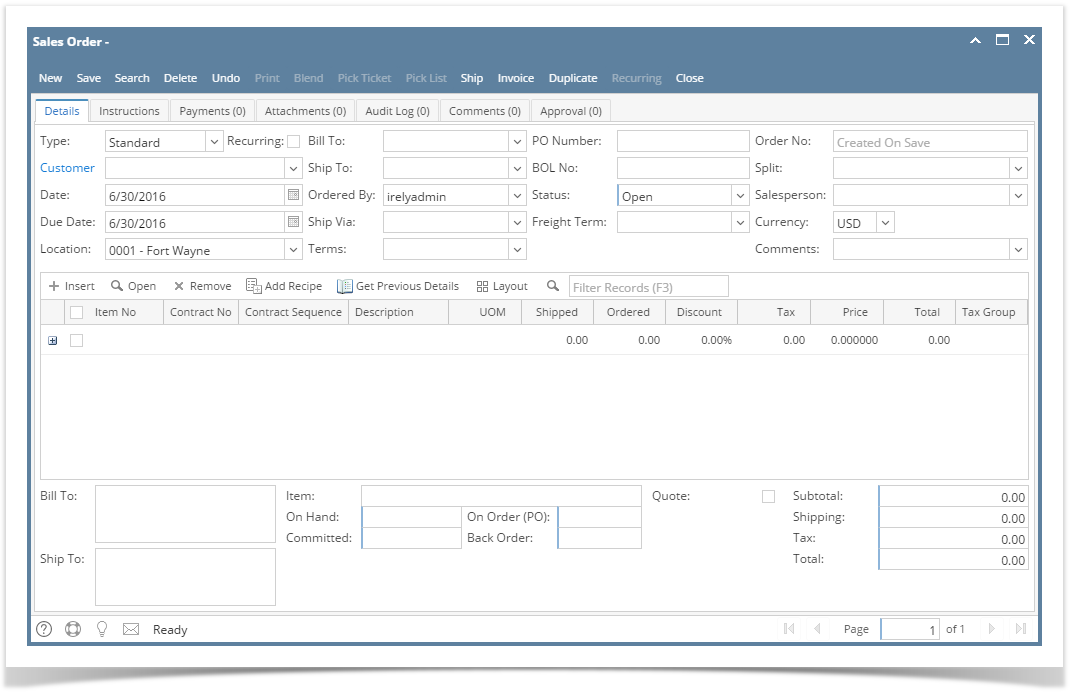
Field Description
Header Details:
Type - This field will default to Standard. Used this field to determine what type of transaction you are intending to create or process. The options are Standard and Software.
Recurring - Check this option if the sales order will be converted to a recurring template. Refer to How to Create Sales Order Recurring Template
Customer - Select a Customer from the combo list box. Some of the fields, like Bill To, Ship To, Ship Via, Terms, Freight Terms, Salesperson, and Currency, are filled in with details in Customer screen.
Date - This will default to today's date. This can be changed to whatever date the customer placed the order.
Due Date - This is a computed date based on the Terms used and Date.
Location - By default, this field is populated with the default location assigned to the user. Click the combo box button and select another location if necessary. Note that the list shows the active Company Location records only. If the Location you need is not in the list, you will have to add it to the Company Locations screen.
Bill To - By default, this field will show the assigned Bill To to the selected customer. This can be changed to another Bill To location if necessary.
Ship To - By default, this field will show the assigned Ship To to the selected customer. This can be changed to another Ship To location if necessary.
Ordered By - Use this field to show the order taker.
Ship Via - This field will display the default Ship Via of the selected Ship To. You can select another Ship Via from the combo list box if necessary. If the Ship Via you need is not the in the list, you will have to add it to the Ship Via [OBSOLETE] screen.
Terms - This field will display the default Terms of the selected Customer. You can select another Terms from the combo list box if necessary. If the Terms you need is not in the list, you will have to add it to the Terms screen.
PO Number - Enter in this field the Customer's Purchase Order number provided to you for this order.
BOL No - Use this field to enter the bill of lading for the freight services.
Status - Select a new status from the combo list box to show the current status of the order. Your choices are Open, Pending, Partial, Closed, Cancelled, and Short Closed. A new sales order will have a Open status by default. Refer also to How to Process Sales Order to Invoice and How to Process Sales Order to Inventory Shipment
Freight Terms - This is the freight terms applicable to the Ship To location. Click the combo box button and selected a different term if necessary. If the Freight Terms you need is not in the list, you will have to add it to the Freight Terms screen.
Order No - This field is blank by default. A unique and system generated ID will fill in this field upon saving the new sales order. This ID is configured on Starting Numbers screen.
Split - This will define how the order amount will be split between the customers defined in the Entity Split. You can select the appropriate split number from the list. To add new customer splits, refer to How to Add an Entity Split.
Salesperson - This field will display the default Salesperson of the selected customer. You can select another Salesperson from the combo list if necessary. If the Salesperson is not in the list, you will have to add it to the Salesperson screen.
Currency - This field is used to assign a default currency for each Credit Memo. Upon opening the screen, the Currency value is from Company Configuration | System Manager | Functional Currency. Once a customer is selected, this field will get the default currency assigned to the customer. You can still override the Currency if necessary. If the currency you need is not in the list you, will have to add it to the Currency screen.
Comments - Use this field to enter additional information about the sales order.
Grid Details:
Item No - Click the combo box button and select the correct item from the list. The combo list box will display the items available on the selected Location only. Some of the fields, like Description, UOM, and Price, are auto-populated with the details in the item record.
Contract No - If needed, click the combo box button and select the appropriate contract for this item.
Contract Sequence - Click the combo box button and select the sequence number associated to the selected Contract Number.
Description - This field will display the description of the selected item. You can edit the description if necessary.
UOM (Unit of Measure) - The field will display the default issue UOM of the Item Location. You can select a new UOM if necessary.
Shipped - This will default to 1.00. Enter the quantity that will be shipped to the customer.
Ordered - This field is read-only.
Discount - This will display 0.00% by default. Enter the discount percentage you want to give the customer on the selected item. If you want to give the customer a 5% discount when purchasing a particular item enter 5 in this field.
Tax - This is computed based on the taxing setup of the item and customer. Field is also read-only.
Price - This will display the default Sale Price of the selected Item. You can update this if necessary.
Total - This is computed based on the value in Ordered, Discount, and Price field. Field is also read-only.
Tax Group - Click the combo box button and select the Tax Group applicable for the item.
Footer Details:
Bill To - This disabled field will display the complete address of the bill to assigned to the Credit Memo.
Ship To - This disabled field will display the complete address of the ship to assigned to the Credit Memo.
Item Information - These disabled fields will display the stock details of the selected item.
- Item - will display the Item Number and Description of the selected item in the grid.
- On Hand - displays the total on hand quantity. This field changes every time an item is sold or purchased.
- Committed - displays the total quantity of the selected inventory item that has been ordered but not yet invoiced/shipped.
- On Order (PO) - displays the total quantity on order. This field changed every time a purchase order for the selected inventory item is created.
- Back Order - displays the total quantity on back order. This field changes every time an invoice for the selected inventory item is posted where there are not enough stock to complete the order (Shipped qty is less than Ordered qty).
Amount Information
- Subtotal - This field will display the total of all the line items entered in the grid.
- Shipping - This field will display the shipping cost of the transaction.
- Tax - This field will display the total tax of all the line items.
- Total - This field will display the total of the transaction which the customer owes you. This is the summation of Subtotal, Shipping, and Tax.
Pages
- How to Create Standard Sales Order
- How to Create Software Type Sales Order
- How to Add a Recipe with Customer specified to the Sales Order
- How to Create Sales Order Recurring Template
- How to Duplicate Sales Order
- How to Process Sales Order to Inventory Shipment
- How to Process Sales Order to Invoice
- How to Delete Sales Order Line Item
- How to Delete Sales Order
- How to Print Sales Order Report
- How to Print Pick Ticket Report
- How to Add Finished Good item in Sales Order and Manually Blend it
- How to Process Sales Order with Blend to Invoice
- Quote
- How to Create Standard Quote
- How to Create Software Type Quote
- How to Create a 'Price Only' Quote
- How to Create Preliminary Quote
- How to Duplicate a Quote
- How to Process Quote to Sales Order
- How to Delete Quote Line Item
- How to Delete Quote
- How to set Quote Status to Lost
- How to set Quote Status to Expired
- How to Print Quote Report
- How Template affects Printing of Quote
- How Template affects the Quote Report Format
- How to Add a Recipe without Customer specified to the Sales Order
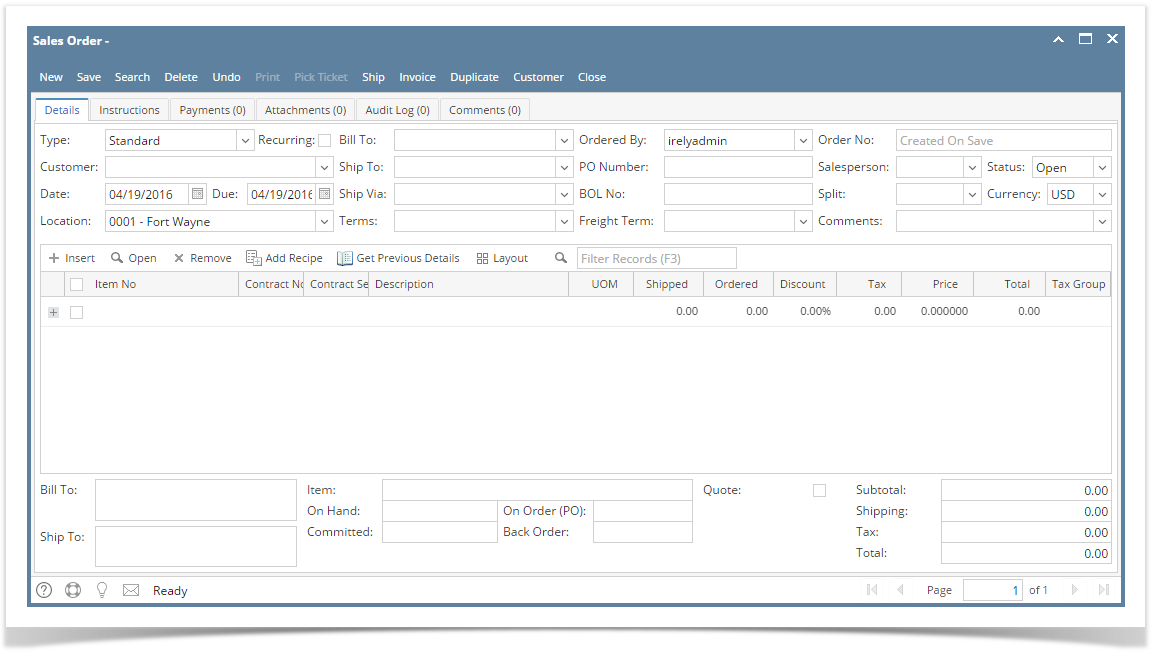

Field Description
Same with above.
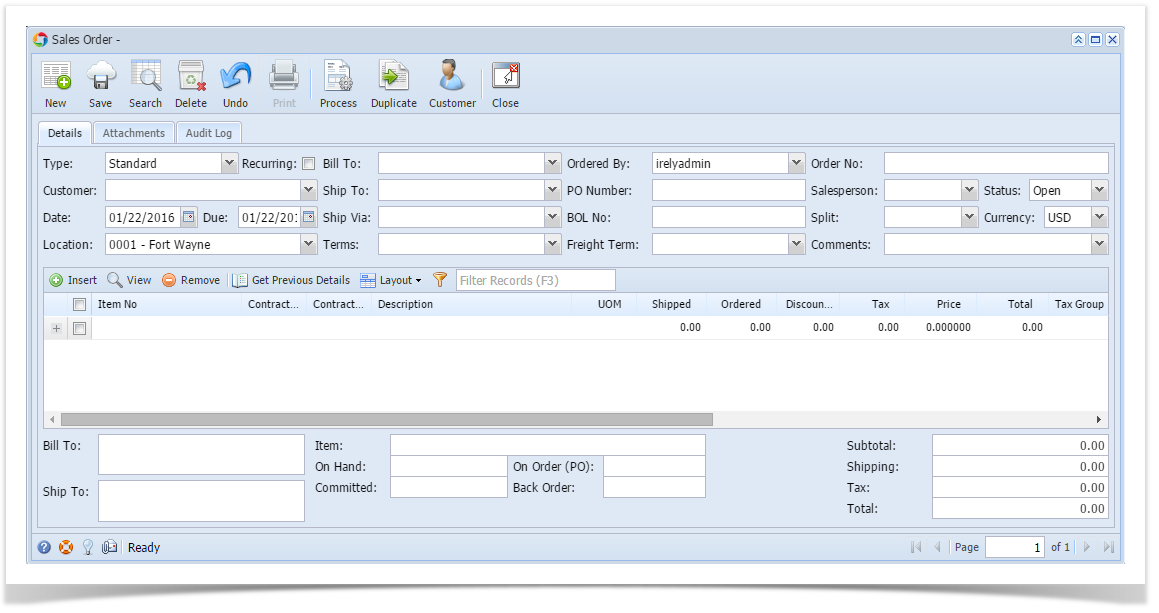
Field Description
Same with above.
The Sales Order screen allows you to create, edit, and view Orders placed by your customer for the inventory items you sell. This is the first step to creating an Invoice.
Open the screen from Sales | Sales Orders menu. If there is no existing record yet, it will open a new Sales Order screen.
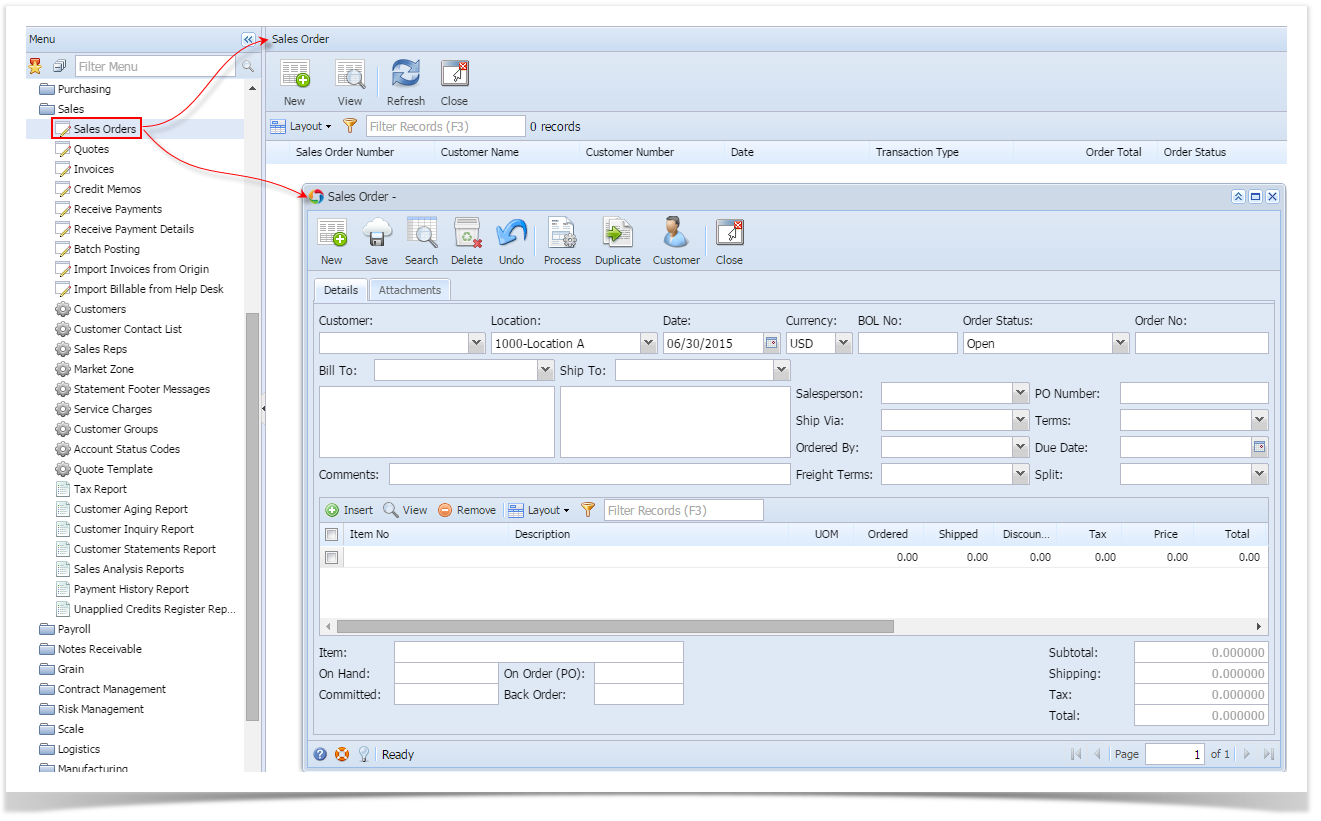
Field Description
Header Details:
Customer - Select a Customer from the combo list box. Some of the fields, like Bill To, Ship To, Salesperson, Ship Via, Terms, and Due Date, are filled in with data based on the selected Customer.
Location - By default, this will show the default location assigned to a user. You can select another location if necessary. Note that the list shows the active Company Location records only. If the Location you need is not in the list, you will have to add it to the Company Locations screen.
Date - This will default to the current system sate. This can be changed to whatever date the customer placed the order.
Currency - This field is used to assign a default currency for each Invoice. This will default to the set Currency on Company Preferences. You can still override the Currency if necessary. If the currency you need is not in the list you, will have to add it to the Currency screen.
BOL No - Use this field to enter the bill of landing for the freight services.
Order Status - Select a new status from the combo list box to show the current status of the order. Your choices are Open, Pending, Partial, Closed, Cancelled, and Short Closed. A new sales order will have a Open status by default. Refer also to How to Process Sales Order to Invoice.
Order No - This field is blank by default. A unique and system generated ID will fill in this field upon saving the new sales order. This ID is configured on Starting Numbers screen.
Bill To - By default, this field will show the assigned Bill To to the selected customer. This can be changed to another Bill To location if necessary. The box below this field is read-only and will show the complete address of the selected Bill To.
Ship To - By default, this field will show the assigned Ship To to the selected customer. This can be changed to another Ship To location if necessary. The box below this field is read-only and will show the complete address of the selected Ship To.
Salesperson - This field will display the default Salesperson of the selected customer. You can select another Salesperson from the combo list if necessary. If the Salesperson is not in the list, you will have to add it to the Salesperson screen.
PO Number - Enter in this field the Customer's Purchase Order number provided to you for this order.
Ship Via - This field will display the default Ship Via of the selected customer. You can select another Ship Via from the combo list box if necessary. If the Ship Via you need is not the in the list, you will have to add it to the Ship Via [OBSOLETE] screen.
Terms - This field will display the default Terms of the selected Customer. You can select another Terms from the combo list box if necessary. If the Terms you need is not in the list, you will have to add it to the Terms screen.
Ordered By - Use this field to show the order taker.
Due Date - This is a computed date based on the Terms used.
Comments - Use this field to enter additional information about the sales order.
Freight Terms - This is the freight terms applicable to the Ship To location. If the Freight Terms you need is not in the list, you will have to add it to the Freight Terms screen.
Split - This will define how the order amount will be split between the customers define in the Customer Split. You can select the appropriate split number from the list. To add new customer splits, refer to How to Add an Entity Split. Business logic is not yet implemented.
Grid Details:
Item No - Click the combo box button and select the correct item from the list. The combo list box will display the items available on the selected Location only.
Description - This field will display the description of the selected item.
UOM (Unit of Measure) - The field will display the default issue UOM of the Item Location. You can select a new UOM if necessary. If the UOM you are looking for is not in the list, you will have to add it to the list of UOMs for that Item.
Ordered - Enter the correct ordered quantity.
Shipped - This field is read-only will be automatically updated when the order has been processed to Inventory Shipment or Invoice.
Discount - This will display 0.00 by default. Enter the discount percentage you want to give the customer on the selected item. If you want to give the customer a 5% discount when purchasing a particular item enter 5 in this field.
Tax - This is computed based on the taxing setup of the item and customer.
Price - This will display the default Sale Price of the selected Item. You can update this if necessary.
Total - This is computed based on the value in Ordered, Discount, and Price field.
Bottom fields:
Subtotal - This field will display the total of all the line items entered in the grid.
Shipping - not yet implemented.
Tax - This field will display the total tax of all the line items.
Total - This field will display the total of the transaction which the customer owes you. This is the summation of Subtotal, Shipping, and Tax.
The Sales Order screen allows you to create, edit, and view Orders placed by your customer for the inventory items you sell. This is the first step to creating an Invoice.
Open the screen from Accounts Receivable > Activities > Sales Order menu.
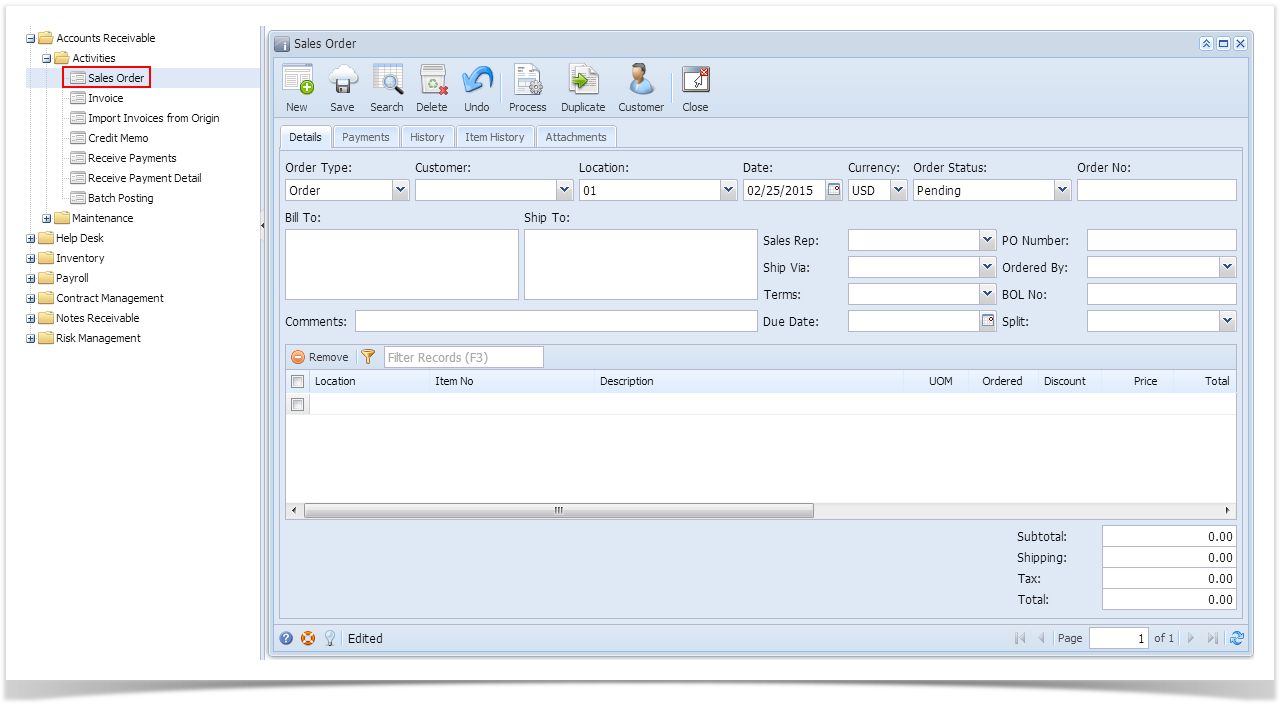
Field Description
Header Details:
Order Type - This field is used to determine what type of transaction you are intending to create or process. The choices are Order and Back Order.
Customer - Select a Customer from the combo list box. Some of the fields, like Bill To, Ship To, Sales Rep, Ship Via, Terms, and Due Date, are filled in with data based on the selected Customer.
Location - By default, this will show the default location assigned to a user. You can select another location if necessary. Note that the list shows the active Company Location records only. If the Location you need is not in the list, you will have to add it to the Company Locations screen.
Date - This will default to the current system sate. This can be changed to whatever date the customer placed the order.
Currency - This field is used to assign a default currency for each Invoice. This will default to the set Currency on Company Preferences. You can still override the Currency if necessary. If the currency you need is not in the list you, will have to add it to the Currency screen.
Order Status - Select a new from the combo list box to show the current status of the order. Your choices are In Process, Pending, On Hold, or Approved. A new sales order will have a Pending status by default. Once an order is already processed to Invoice, its status will automatically show Complete. Refer also to How to Process Sales Order to Invoice.
Order No - This field is blank by default. A unique and system generated ID will fill in this field upon saving the new sales order. This ID is configured on Starting Numbers screen.
Bill To - This area will display the details of the Customer Location assigned as a customer Bill To.
Ship To - This area will display the details of the Customer Location assigned as a customer Ship To.
Sales Rep - This field will display the default Salesperson of the selected customer. You can select another Salesperson from the combo list if necessary. If the Salesperson is not in the list, you will have to add it to the Salesperson screen.
Ship Via - This field will display the default Ship Via of the selected customer. You can select another Ship Via from the combo list box if necessary. If the Ship Via you need is not the in the list, you will have to add it to the Ship Via [OBSOLETE] screen.
Terms - This field will display the default Terms of the selected Customer. You can select other Terms from the combo list box of necessary. If the Terms you need is not in the list, you will have to add it to the Terms screen.
Due Date - This is a computed date based on the Terms used.
PO Number - Enter in this field the Customer's Purchase Order number provided to you for this order.
Ordered By - not yet implemented.
BOL No - not yet implemented.
Split - not yet implemented.
Comments - Use this field to enter additional information about the sales order.
Grid Details:
Location - Select the same as the location field in the header area, but used to filter the items listed on the Item No combo list box.
Item No - Click the combo box button and select the correct item from the list. The combo list box will display the items available on the selected Location only.
Description - This field will display the description of the selected item.
UOM (Unit of Measure) - The field will display the default issue UOM of the Item Location. You can select a new UOM if necessary. If the UOM you are looking for is not in the list, you will have to add it to the list of UOMs for that Item.
Ordered - This will default to 1.00. Enter the correct ordered quantity.
Discount - This will display 0.00 by default. Enter the discount percentage you want to give the customer on the selected item. If you want to give the customer a 5% discount when purchasing a particular item enter 5 in this field.
Price - This will display the default Sale Price of the selected Item. You can update this if necessary.
Total - This is computed based on the value in Ordered, Discount, and Price field.
Bottom fields:
Subtotal - This field will display the total of all the line items entered in the grid.
Shipping - not yet implemented.
Tax - not yet implemented.
Total - This field will display the total of the transaction which the customer owes you. This is the summation of Subtotal, Shipping, and Tax.
- No labels